|
 Cortinarius peraurantiacus Cortinarius peraurantiacus
SynonymsThaxterogaster aurantiacus
BiostatusPresent in region - Indigenous. Endemic
Images (click to enlarge)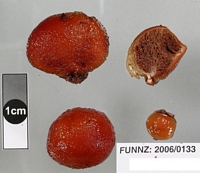
Caption: Col. DAO 2099, FUNNZ: 2006/0133, See public note for more information
Owner: FUNNZ | 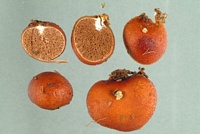
Caption: Fruiting bodies 15-30 mm diam.
Owner: Herb PDD | 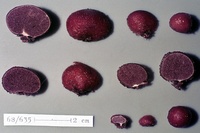
Caption: ZT68-635
Owner: E. Horak: © Creative Commons Attribution-Noncommercial 3.0 New Zealand | 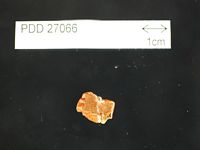
Caption: Dried type specimen
Owner: Herb PDD | 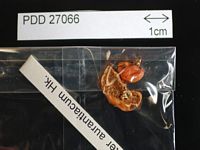
Caption: Dried type specimen
Owner: Herb PDD | 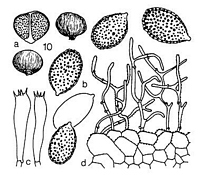
Caption: Thaxterogaster
aurantiacum Hk. sp.n. (type): a. fruitingbodies.
b. spores. c. basidia. d. cuticle. | 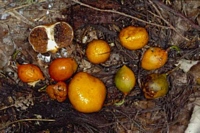
Owner: R.E. Beever | 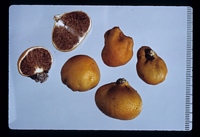
Owner: Herb. PDD | 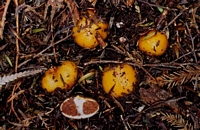
Caption: REB 1345 AK, Goldies Bush, 19/6/93 [REB 1345 not listed, possibilities are 1362,1361]
Owner: Ross Beever |
Article: Horak, E. (1973). Fungi Agaricini Novazelandiae I-V. Beihefte zur Nova Hedwigia 43: 200 p.
Description: Gastrocarp
10-20 mm diam., globose or ovoid, subhypogaeous buried among litter, peridium
deep orange, golden yellow or reddish brown, mucilaginous, very glutinous, cuticle
cartilaginous, up to 2 mm diam., margin of peridium not dehiscent from the base
of the stipe, veil remnants absent. Gleba loculate, cells 1-2 mm diam., not
radially arranged, without branching tramal plates, rust brown, neither exposed
nor dehiscent from stipe (columella).
Stipe
-15 x -3(5) mm, turbinate or bulbous-marginate at the base, strongly tapering
towards the apex or absent, columella not branched, merging into central parts
of peridium. Context whitish, tough. Odor and taste nor distinctive. Chemical
reactions on peridium: KOH - negative.
Spores
13-15 x 7-9 µm, elliptic, verrucose, warts tubular and coarser towards the apex,
perisporium well developed, ferruginous. Basidia 30-45 x 9-12 µm, 4 spored.
Cystidia absent. Epicutis consisting of highly gelatinised, cylindric (2-7 µm
diam.), thin-walled hyphae, encrusted with brown pigment; subcutis cellular.
Clamp connections present.
Habitat: In soil amongst litter, under Leptospermum
scoparium, Knightia sp., Cyathea sp., etc. New Zealand.
Notes: New Zealand a closely related form of this species is known to grow under Nothofagus
(N. fusca, N. menziesii). This variety is distinguished from the type by
its slightly larger spores, more gelatinous peridium and in many cases the beech
forest inhabiting species does not have a well developed stipe and the columella
is often absent or rather oblique (see Herb. HK. ZT 67/159; 68/635).
|